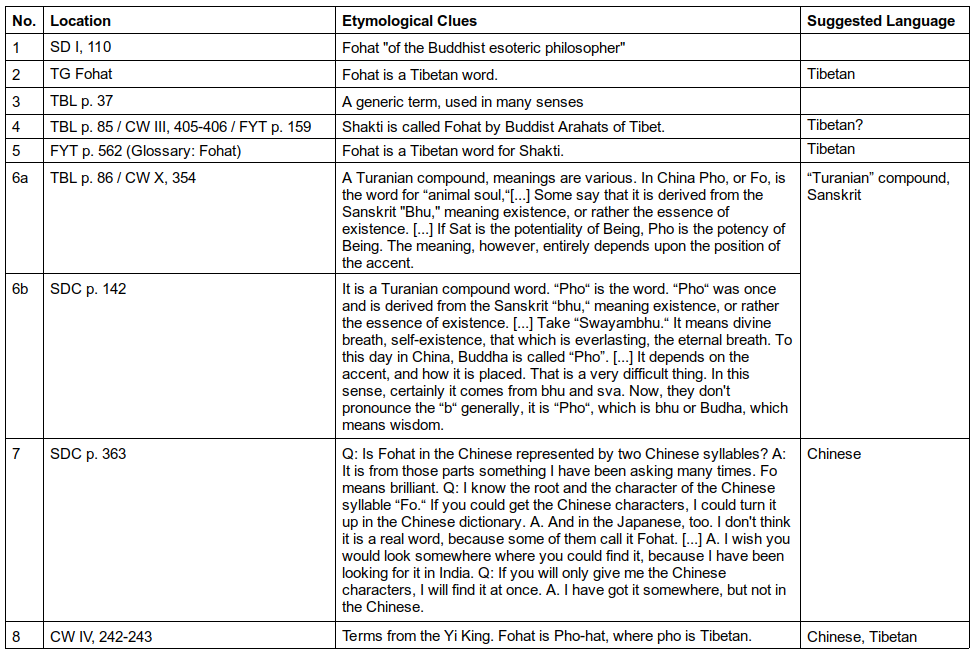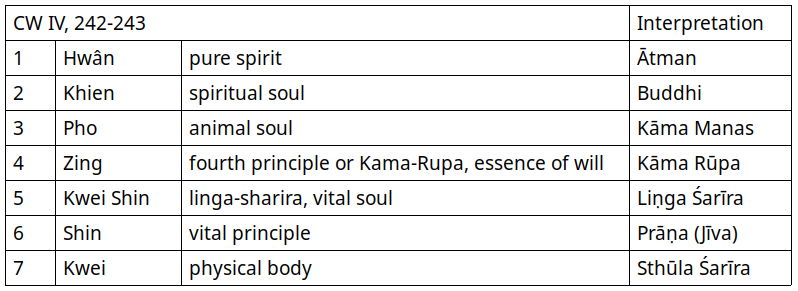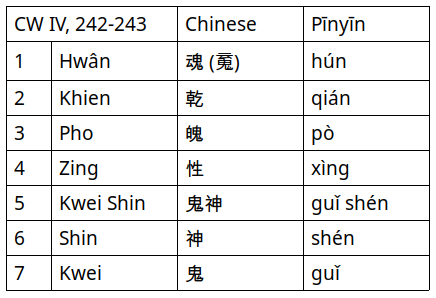Introduction
In the great play called The Secret Doctrine (SD), perhaps the most important actor is fohat, and certainly the most enigmatic. The term has not yet been identified as part of any known language, although several suggestions are given by H.P. Blavatsky (HPB) in the SD and some of her other writings.
Many of the terms used in the SD were also used in Isis Unveiled (IU), the work HPB considered as a precursor of the SD. The term fohat however, is an exception in this respect. It was used in instructions of the Masters of Wisdom to A.P. Sinnet and A.O. Hume in September or October 1881. Sinnett’s notes of these instructions were published as Appendix II in The Letters of H.P. Blavatsky to A.P. Sinnett p. 376-386 under the title Cosmological Notes, and later partly as letter no. I in The Early Teachings of the Masters p. 184-193 (through question no. 16). It appeared in Mahātma letter no. XIII (Barker, i.e. 44 chronological) from M. to A.P. Sinnet, received January 1882 at Allahabad.
It first appeared in theosophical literature in 1882, when HPB wrote an editor’s note to T. Subba Row’s article The Aryan-Arhat Esoteric Tenets on the Sevenfold Principle in Man. (The Theosophist, Vol. III No. 4, January 1882, p. 93-99, later published in CW III, 400-418)

From then onwards, the term was used in HPB’s publications, various letters from the Masters of Wisdom, other writings by theosophists and other authors.
If we trace the locations where the term fohat is mentioned in this initial phase, we can set up a list of direct references to the meaning of the word or its etymology. In the table on page 1, these locations are listed, each with a short indication of their content and a suggested language if explicitly mentioned. The suggested languages are, in order of high to low frequency: Tibetan, Turanian, Sanskrit and Chinese. The word Turanian is used by HPB in a way that was common in her time, to indicate what we would now call the Altai or Altai-Uralic language family. If we consider the languages in terms of language families besides the Altai or Altai-Uralic, we can see that Chinese and Tibetan are members of the same language family, that is the Sino-Tibetan language family, whereas Sanskrit is a member of the Indo-European language family. The eight clues therefore point to three different language families. If words are of the same language family, that means that they may have cognate roots. If they are not, they may be related typically because they may be borrowed from languages belonging to the different language family. The fact that the different clues are pointing to several different language families, raises the question: is this puzzle solvable provided that all of the clues are valid? We will now analyse the different clues to see if we can find out more on the origin of the term fohat.
Clues 1-5: “a Tibetan Term”
In many places in the SD, HPB mentions that fohat is a buddhist term, used by occultists, esoteric philosophers, the brotherhood north of the Himalayas, the arahats of Tibet etc. In the Tibetan alphabet however, there is no letter “f”, and the language does not have sounds quite similiar to the English “f”. The letter “pha” is perhaps closest to our “f”. It is unclear why fohat is most often written with “f”. The syllable structure in Tibetan is subject to strict rules, which allow only for the two syllables being fo and hat, and not, for example, foh and at. If it would be a Tibetan “compound” word, it would therefore be a combination of the sounds fo and hat, perhaps most likely pho and hat. In location 8 it is spelled as “Pho-hat”, suggesting that it is indeed this two-part compound. In location 6 it is also suggested that fohat might be a compound, optionally bilingual. In location 5, in the Glossary near the end of Five Years of Theosophy, page 562, we find again “Fohat, Tibetan for Sakti: cosmic force or energizing power of the universe.”. In modern and older Tibetan dictionaries there is no mention of a word pho hat, or pho, with a meaning anywhere near our enigmatic term from the SD.
As a sidenote: we may be inclined to think that mahat and fohat are etymologically related, but in the case of fohat being a Tibetan compound this would not be possible. Mahat is a present active participle from the Sanskrit root “mah”, “to be or make great or big”. It means “making great” or “being big”, expressing the important role that was attributed to intellect or intelligence in ancient Indian philosophy. Being derived from the root mah plus ending -at, mahat is composed differently than fo/pho plus hat.
The numbers 6a and 6b are different renderings of the same question-and-answer session, so that we can take them together as one location.
Clue 6: “a Turanian compound” and Sanskrit bhū
That a word would be a “Tibetan term” on the one hand and a “Turanian compound” on the other, are in principle two linguistically incompatible statements, so strictly speaking the clues 1-5 and 6 contradict each other. The attributes Tibetan and Turanian (Altai-Uralic) point to different language families, but these particular languages are used in neighbouring areas, which is why, for example, a word is likely to have a false etymology, while in reality it is borrowed from one of the two. Another explanation might be that HPB received different pieces of information in the course of time. In any case, it remains up to us to decide which of the given options are correct. After a searching a selection of current literature, dictionaries and etymological databases, no Altai-Uralic candidates for “fo” or “hat” were found.
In location 6, a second idea is presented: the Chinese word “pho” being derived from the Sanskrit root bhū. This derivation is implausable, again because Chinese and Sanskrit are generally considered unrelated languages. Although there has been a lot of work done to try to unite the known language families into superfamilies, the Sino-Tibetan and Indo-European families are among the most unlikely partners. Moreover, we can see that the semantic fields of the Chinese and Sanskrit roots pho and bhū have nothing in common.
Clue 7: “Chinese characters”
Like locations 6a and 6b, location 7 is part of the transactions of the Blavatsky Lodge, but it was not published in the book bearing that title. These transactions were question-and-answer sessions, where HPB answered questions of the lodge members about successive stanzas from the Book of Dzyan. The larger part of the original handwritten notes of these sessions was recovered by Daniel Caldwell in 1995 and published in book form by Michael Gomes in 2010.
On March 28, 1889, the twelfth session was held at 17, Lansdowne Road, Holland Park, London, where a Mr. Atkinson (William Walker Atkinson), one of the participants who knew some Chinese, asks HPB if she could give the Chinese characters of the word fohat, to be able to look it up in a Chinese dictionary. On the question if the Chinese representation of the word consists of two syllables, HPB answers:
It is from those parts something I have been asking many times. Fo means brilliant. […] Mme. Blavatsky: I wish you would look somewhere where you could find it, because I have been looking for it in India. Mr. Atkinson: If you will only give me the Chinese characters, I will find that at once. Mme. Blavatsky: I have got it somewhere, but not in the Chinese.
It is remarkable that she gives yet another meaning of “fo”. In a modern Chinese dictionary the syllable fo is easy to identify, since there is only one matching syllable and character, which is 佛, fó, with rising tone, meaning Buddha. This syllable is mentioned several times by HPB, also as the origin of the first part of the word fohat. In fact, this syllable fó is borrowed from Sanskrit, as a Chinese rendering of “bu” in “buddha”. Probably the idea that the origin of fo(hat) is the Sanskrit root bhū is based on this, as HPB connects these two in location 6b. However, the two roots bud (to awaken, in “Buddha”) and bhū (to be) are unrelated. The syllable fó only means “Buddha” and not “brilliant”, so for clue 7 we are at a clear dead end.
Clue8: “Pho-hat” and the I Ching
Location 8 (CW IV, 242-243) is a footnote by HPB to an article on the sevenfold in Zoroastrianism, Theosophy and the Avesta, in The Theosophist Vol. IV, No. 1, October, 1882, p. 22. The footnote starts with:
Our Brother has but to look into the oldest sacred books of China—namely the Yi King, or Book of Changes (translated by James Legge) written 1200 B.C., to find that same Septenary division of man mentioned in that system of Divination.
Then seven Chinese terms are mentioned in connection with the seven human principles, see the following table.

The first edition of James Legge’s translation of the I Ching, published in 1882, is the only Western language edition published in HPB’s time. Following HPB’s advice, we have consulted this edition. We find that some of the terms of the “septenary division” are discussed in chapter three, so that we can determine the correct Chinese spelling. But again, our candidate for “fo”, the animal soul, “Pho”, is not to be found there.

If we continue reading the footnote, we find a reference to A Dissertation on the Theology of the Chinese by Walter Henry Medhurst, published in Shanghai in 1847. In this work we also find the terms of HPB’s septenary division, with their correct Chinese spelling. If we put together the information from Legge and Medhurst, we can set up another table, containing the orthography of all seven terms.
On page 5 in “A Dissertation…” we find: “The 鬼 kweì or 魄 pĭh in man, is the anima or grosser part of his spiritual nature […]”. If we look up the character 魄 in a modern Chinese dictionary we find that in modern pīnyīn transliteration it is spelled pò, and that its general meaning is “animal soul”. Could this be the “pho” of the septenary division? HPB writes in location 8:
In the Hwân, or soul (animus), the Khien predominates, and the Zing in the Pho or animal soul. At death the Hwân (or spiritual soul) wanders away, ascending, and the Pho (the root of the Tibetan word Pho-hat), descends and is changed into a ghostly shade (the shell).

From this sentence it is already clear without a doubt that this pho, or, as we now know, 魄 (pò), is indeed a rendering of the first syllable of the word fohat.
This character pò (魄), composed of 白 (bái) and 鬼 (guǐ), is found in some of the oldest Chinese dictionaries, the Ěryǎ (爾雅) and the Shuō wén jiě zì (說文解字), dating from the 3rd century BCE and the early 2nd century CE respectively. Very likely, it predates the Han-dynasty (206 BCE-220 CE). A substantial lemma is found in the Kāng Xī dictionary (康熙, 1716 CE). Linguists see cognates in the Tibetan words bla (soul, spirit) and zla (moon). (James A. Matisoff and others) The character is used in the Tao Te Ching (道德經), Lǎozi’s well known (arguably) 6th century BCE classic, where it is used in the sense of “animal soul”. (10.1) Another example of a relevant text is the The Secret of the Golden Flower (太乙金華宗旨, Tài Yǐ Jīnhuá Zōngzhǐ), a Taoist alchemical work translated by Richard Wilhelm and published in German in 1929. In 1931 an English translation (from German, by Cary F. Baynes) was published, with a preface by Carl Gustav Jung.
In the present article only the etymological dimension is investigated. Religious and philosophical aspects may be discussed in a second article.
Conclusions
Of the eight etymological clues, only the last one holds up.
Clues 1-5: The idea that fohat is a Tibetan word is not disproven entirely, but it is implausible, and a corresponding Tibetan root is not found.
Clue 6: Fohat being a Turanian compound is equally implausible. No cognate Altai-Uralic roots were found in current literature, dictionaries or etymological databases.
Clue 7: The first syllable being derived from the Chinese word for Buddha, which is the syllable 佛 (fó), or from the Sanskrit root bhū is both implausible.
Clue 8: The first syllable fo can be traced back to the Chinese character 魄 (pò), meaning “soul”, or “animal soul”. It has a role in Chinese traditional religion and philosophy which is at the basis of the cosmology and divination system of the I Ching.
Having exhausted all of HPB’s clues, a next step could be to find relevant original texts in the field of Chinese traditional religion. This would enable us to gather more information on fohat to be able to shed more light on the many remaining questions. A lot of useful information is already available in Medhurst’s 1847 work, but there will also be modern scholarly works perhaps presenting a more comprehensive picture. ■
© 2023 Ingmar de Boer, published in The Netherlands
Download as PDF:
Timestamp verification file download
Thanks for your positive comments! (Robert and Noel) I am a little late with my response. The Kalmucks indeed play a special role in HPB’s youth. I have checked for example some Kalmykian dictionaries, besides Mongolian dictionaries, for the technical terms still left to identify. You are right in saying that they have Tibetan Buddhist influences and speak an Altai-Uralic language. Visiting Kalmykia (as a Dutchman) seems unwise or even impossible at the moment, although I have fantasised about it once or twice in the past.
A quite fascinating comparative study (the book, not the article) about Bo and Bön has been written written by Dmitry Ermakov, showing that Tibetan Bön forms a single continuum with shamanistic religions from Siberia, like Buryatian Bo, centered around Lake Baikal. See https://www.boandbon.com/ The main Gods, the Tengeri, form a sevenfold. (As you may know, theosophists have a special relationship with sevenfolds…) This kind of comparative research in this geographic area appears to still have a promising future.
I have recovered some of my notes about the Mongolian/Kalmykian connection, for example HPB’s visits to Astrakhan. I think, in time, I will prepare a post on the basis of these notes, as a starting point for those who would like to further pursue in this direction.
Thank you, Ingmar, for this valuable survey.
One of your remarks caught my attention: “The attributes Tibetan and Turanian (Altai-Uralic) point to different language families, but these particular languages are used in neighbouring areas, which is why, for example, a word is likely to have a false etymology, while in reality it is borrowed from one of the two.”
– Indeed a path seems opened by the attestation made by H.P.B. herself of her first acquaintances with the Buddhist world, during her childhood in Astrakhan: that of the “Buddhist kalmuks”, specifically, with whom she maintained regular contacts for many years. Due to its geographical base, the Kalmuk people may have undergone clear Uralo-Altaic influences as well as Tibetan ones. The Kalmik language now has only some 150,000 speakers, but it is likely that as a Republic of the Russian Confederation, its linguistic heritage has been the subject of conservatory measures. Perhaps, by questioning local University, Buddhist documents written in Kalmik can be obtained, where our enigmatic Fohat would finally make his appearance. It could be an alteration as well as a term of strictly local use.
I also remember a short novel by H.P.B., published in the Russky Vyestnik, where a “Bikshuni” met on a road of North India uses the expression “the world of Foh” (For “Buddha”, to evoke a luminous plane beyond the material and corruptible world.But it may be a fantasy of “Raddha Bay”.
Kind regards
N.R.N.
Excellent survey!